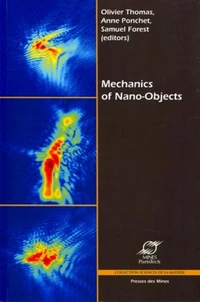Mechanics of Nano - Objects
Par : , ,Formats :
Disponible dans votre compte client Decitre ou Furet du Nord dès validation de votre commande. Le format PDF est :
- Compatible avec une lecture sur My Vivlio (smartphone, tablette, ordinateur)
- Compatible avec une lecture sur liseuses Vivlio
- Pour les liseuses autres que Vivlio, vous devez utiliser le logiciel Adobe Digital Edition. Non compatible avec la lecture sur les liseuses Kindle, Remarkable et Sony
 , qui est-ce ?
, qui est-ce ?Notre partenaire de plateforme de lecture numérique où vous retrouverez l'ensemble de vos ebooks gratuitement
Pour en savoir plus sur nos ebooks, consultez notre aide en ligne ici
- Nombre de pages378
- FormatPDF
- ISBN978-2-35671-304-9
- EAN9782356713049
- Date de parution21/09/2015
- Protection num.pas de protection
- Infos supplémentairespdf
- ÉditeurPresses des Mines - Transvalor
Résumé
In nanoscience, one always has to question how the basic theories we use at the macro- and meso- scales (continuum elasticity and plasticity, etc) apply at the nanometre scale. Studying mechanical properties of nano-size objects also challenges the experimental approaches: how to implement reproducible and controllable mechanical loading? How to measure fields (displacement, stress, strain, etc) with the required nano-resolution? Moreover nanoscience is often tackling the limits of continuum theories and thus simulation is an increasingly important tool to evaluate the different scale transitions needed from atoms to nano-objects.
This book provides an updated view of the rapidly growing field of mechanical properties of nano-objects like micropillars, nanowires, nano-particles, nano-precipitates, nano-twins, MEMS, NEMS and structured surfaces, etc.
It addresses the theoretical and experimental issues that span the field of mechanics at small dimensions: the fundamentals of continuum mechanics and the mechanics of defects, a general state-of-the-art about modelling and simulation and an overview of the size dependent mechanical properties of nano-objects. Fascinating recent advances are shown in the evaluation of displacement fields at the nano scale by X-ray diffraction and transmission electron microscopy.
Examples are given of systems where mastering mechanical properties in small dimensions is key to control the final aimed property (electrical, optical, mechanical, etc).
It addresses the theoretical and experimental issues that span the field of mechanics at small dimensions: the fundamentals of continuum mechanics and the mechanics of defects, a general state-of-the-art about modelling and simulation and an overview of the size dependent mechanical properties of nano-objects. Fascinating recent advances are shown in the evaluation of displacement fields at the nano scale by X-ray diffraction and transmission electron microscopy.
Examples are given of systems where mastering mechanical properties in small dimensions is key to control the final aimed property (electrical, optical, mechanical, etc).
In nanoscience, one always has to question how the basic theories we use at the macro- and meso- scales (continuum elasticity and plasticity, etc) apply at the nanometre scale. Studying mechanical properties of nano-size objects also challenges the experimental approaches: how to implement reproducible and controllable mechanical loading? How to measure fields (displacement, stress, strain, etc) with the required nano-resolution? Moreover nanoscience is often tackling the limits of continuum theories and thus simulation is an increasingly important tool to evaluate the different scale transitions needed from atoms to nano-objects.
This book provides an updated view of the rapidly growing field of mechanical properties of nano-objects like micropillars, nanowires, nano-particles, nano-precipitates, nano-twins, MEMS, NEMS and structured surfaces, etc.
It addresses the theoretical and experimental issues that span the field of mechanics at small dimensions: the fundamentals of continuum mechanics and the mechanics of defects, a general state-of-the-art about modelling and simulation and an overview of the size dependent mechanical properties of nano-objects. Fascinating recent advances are shown in the evaluation of displacement fields at the nano scale by X-ray diffraction and transmission electron microscopy.
Examples are given of systems where mastering mechanical properties in small dimensions is key to control the final aimed property (electrical, optical, mechanical, etc).
It addresses the theoretical and experimental issues that span the field of mechanics at small dimensions: the fundamentals of continuum mechanics and the mechanics of defects, a general state-of-the-art about modelling and simulation and an overview of the size dependent mechanical properties of nano-objects. Fascinating recent advances are shown in the evaluation of displacement fields at the nano scale by X-ray diffraction and transmission electron microscopy.
Examples are given of systems where mastering mechanical properties in small dimensions is key to control the final aimed property (electrical, optical, mechanical, etc).







